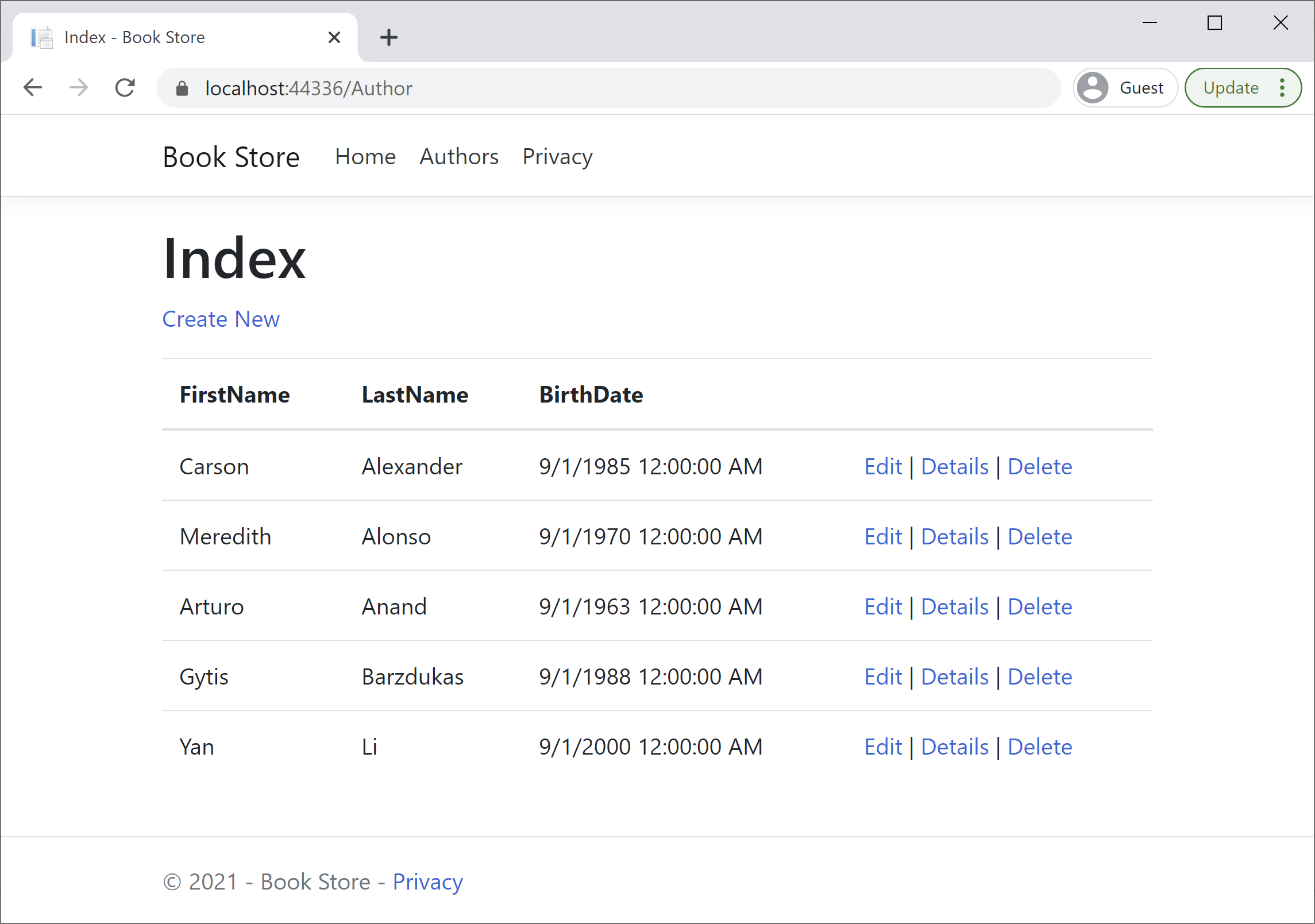Repository Pattern Update Author Controller to Use the Repository
In AuthorController.cs, replace the code currently in the class with the following code.
using System;
using System.Collections.Generic;
using System.Linq;
using System.Threading.Tasks;
using Microsoft.AspNetCore.Mvc;
using Microsoft.AspNetCore.Mvc.Rendering;
using Microsoft.EntityFrameworkCore;
using RepositoryPatternDemo.DAL;
using RepositoryPatternDemo.Models;
namespace RepositoryPatternDemo.Controllers
{
public class AuthorController : Controller
{
private IAuthorRepository repository;
public AuthorController(BookStore context)
{
repository = new AuthorRepository(context);
}
// GET: Author
public async Task<IActionResult> Index()
{
return View(await repository.GetAuthors());
}
// GET: Author/Details/5
public async Task<IActionResult> Details(int? id)
{
if (id == null)
{
return NotFound();
}
var author = await repository.GetAuthorById((int)id);
if (author == null)
{
return NotFound();
}
return View(author);
}
// GET: Author/Create
public IActionResult Create()
{
return View();
}
// POST: Author/Create
// To protect from overposting attacks, enable the specific properties you want to bind to.
// For more details, see http://go.microsoft.com/fwlink/?LinkId=317598.
[HttpPost]
[ValidateAntiForgeryToken]
public async Task<IActionResult> Create([Bind("AuthorId,FirstName,LastName,BirthDate")] Author author)
{
if (ModelState.IsValid)
{
await repository.InsertAuthor(author);
return RedirectToAction(nameof(Index));
}
return View(author);
}
// GET: Author/Edit/5
public async Task<IActionResult> Edit(int? id)
{
if (id == null)
{
return NotFound();
}
var author = await repository.GetAuthorById((int)id);
if (author == null)
{
return NotFound();
}
return View(author);
}
// POST: Author/Edit/5
// To protect from overposting attacks, enable the specific properties you want to bind to.
// For more details, see http://go.microsoft.com/fwlink/?LinkId=317598.
[HttpPost]
[ValidateAntiForgeryToken]
public async Task<IActionResult> Edit(int id, [Bind("AuthorId,FirstName,LastName,BirthDate")] Author author)
{
if (id != author.AuthorId)
{
return NotFound();
}
if (ModelState.IsValid)
{
try
{
await repository.UpdateAuthor(author);
}
catch (DbUpdateConcurrencyException)
{
if (!AuthorExists(author.AuthorId))
{
return NotFound();
}
else
{
throw;
}
}
return RedirectToAction(nameof(Index));
}
return View(author);
}
// GET: Author/Delete/5
public async Task<IActionResult> Delete(int? id)
{
if (id == null)
{
return NotFound();
}
var author = await repository.GetAuthorById((int)id);
if (author == null)
{
return NotFound();
}
return View(author);
}
// POST: Author/Delete/5
[HttpPost, ActionName("Delete")]
[ValidateAntiForgeryToken]
public async Task<IActionResult> DeleteConfirmed(int id)
{
var author = await repository.GetAuthorById(id);
await repository.DeleteAuthor(id);
return RedirectToAction(nameof(Index));
}
private bool AuthorExists(int id)
{
return repository.IsAuthorExists(id);
}
}
}
The controller now declares a class variable for an object that implements the IAuthorRepository interface instead of the context class.
private IAuthorRepository repository;
public AuthorController(BookStore context)
{
repository = new AuthorRepository(context);
}
You can see that in the CRUD methods, the repository is now called instead of the context.
To get all authors, we have used the GetAuthors method.
await repository.GetAuthors();
Use the GetAuthorById method to get an author by id.
var author = await repository.GetAuthorById((int)id);
To insert an author, use the InsertAuthor method.
await repository.InsertAuthor(author);
To delete an author, use the DeleteAuthor method.
await repository.DeleteAuthor(id);
To update an author, use the UpdateAuthor method.
await repository.UpdateAuthor(author);
Press Ctrl+F5 to run the project, click the Authors tab to see the test data.

The pages look and work the same as it did before you changed the code to use the repository.
